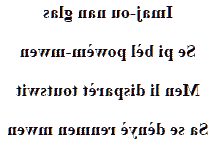Haitian creole love poem
Glas la
Imaj-ou nan glas
Se pi bèl powèm-mwen
Men li disparèt toutswit
Sa se dènyè renmen mwen


→ French poem ←
Haitian woman and her kreyòl
This translation into Haitian Creole (Creole, Fablas, Haitian Creole, Plateau Haitian Creole, Autonym : Kreyòl Ayisyen, Ayisyen), is a nice drawing. Do you recognize yourself in this love poem (powèm lanmou, renmen gade powèm)? You are creole like the coffee of Gainsbourg, and your reflection excites the wildest desires.
Haiti (the pearl of the Antilles), your country, remains a place for tourism because of its beaches and history.
Haitian Creole is a language spoken by 12 million people. It is a Creole of French and various African languages. If we find three dialectal forms, they remain intercomprehensible.
It is with French the official language of Haiti since 1987. Its lexical base is largely French, although its grammar is from African origin. It was born between the 17th and 18th centuries, with contacts between indigenous Indians Tainos, French from Western and Northern France, and slaves deported from West Africa.
This language comes from a need for communication between slaves who spoke different languages including Fon, Mina, Wolof, Mandingo, Hausa, Igbo, Yoruba and Kongo.
The African languages have mainly given to this creole, terms related to voodoo religion, such as wanga which means fetish. We can cite some examples of Creole words originating from the Indian language: "jurumu" which has become "jiwomou" (giraumont, a kind of pumpkin), "kenep" (clustered fruit).
From Spanish there are words like "gagann", which comes from the verb cabecear (to drowse). To illustrate some French predominance, note mize (miser) from West of France, which means "to take his time".
Although this Creole is primarily a language of oral tradition, an official script was promulgated in 1979. This alphabet consists of 32 letters, 18 consonants, 3 semi consonants and 11 vowels. In Creole all letters are pronounced, a double letter gives two sounds: bannann (banana).
History of Creoles
To explain the very process of the emergence of a Creole, there is the Bloomenfield theory, called "baby talk".
This supposes that the Master spoke in a kind of baby language, of "little nigger," which was back imitated. Thus a pidgin is created which, once internalized by the servile society, ends in a Creole, since the speakers of the second and third generations have only that language.
This theory is reinforced by the fact that the displaced populations (slaves) did not all speak the same language, so it was necessary to invent a new idiom to communicate, by appropriating by diverting them, the languages of the white masters.